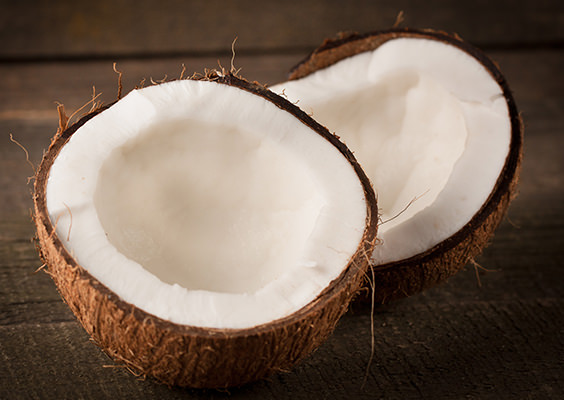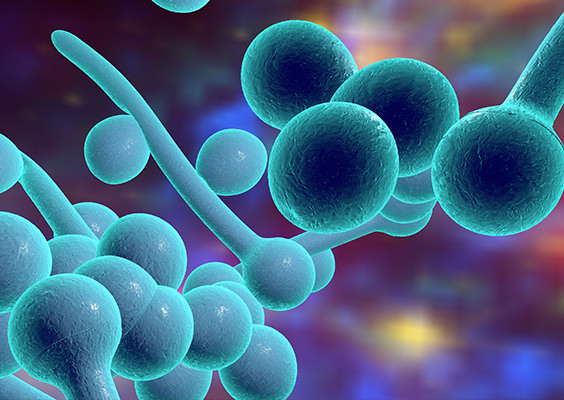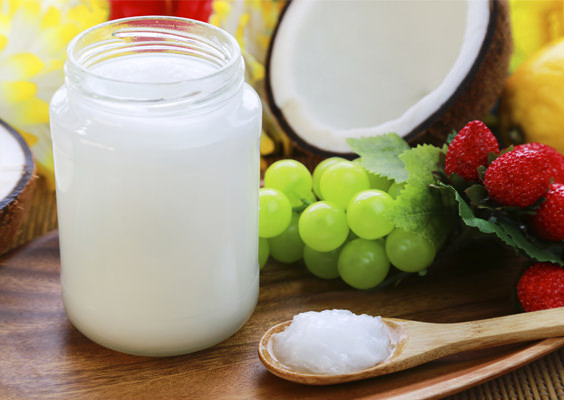I’ve seen the health benefits of coconut among numerous traditional cultures in Bali, India, Peru, Jamaica and various parts of Africa. They use it for almost everything — from lip balm and skin moisturizer to cooking oil and a remedy for stomach complaints.

For years, coconut fat was demonized as the enemy of heart health — until multiple studies revealed that it’s chock full of antioxidants and vitamin E. It also contains a unique kind of fat called medium-chain triglycerides, or MCTs — and these are extremely good for your heart.
Coconut Health Benefits:
- Help prevent obesity by speeding up your metabolism;
- Provide a quick energy boost;
- Reduce sugar cravings;
- Help prevent diabetes by improving insulin efficiency;
- Promote healthy thyroid function;
- Improve symptoms and inflammatory conditions associated with digestive and bowel disorders;
- Support your immune system;
- Break up blood clots;
- Moisturizes and protects skin;
- Repairs dry damaged hair.
Coconuts are also hypoallergenic, and they contain antibacterial, antiviral and anti-parasitic healing properties.
But now researchers have discovered what traditional cultures have known for centuries: Coconut is a powerful anti-fungal treatment — especially against common yeast infections, like Candida albicans.

I’ve been recommending coconut oil to patients as an anti-fungal treatment for years. In a minute, I’m going to show you how you can use it to prevent and treat Candida.
But first, let’s look at how serious this fungal infection really is…
Candida is normally present in your body all the time — but only in small concentrations. The problems begin when your hormones and immunity systems are thrown off balance — often as a result of toxins and fake estrogens in our environment.
That’s when Candida can get out of control. It spreads beyond its normal home in your digestive tract and causes symptoms, like itchy rashes and painful, burning
sensations.Mainstream medicine has a pretty standard response. Doctors often automatically prescribe anti-fungal medicine like fluconazole. Maybe you know this medication as Diflucan. But mainstream treatments for Candida often produce side effects that are worse than the infection itself.
For example, the side effects most commonly reported with fluconazole are:
- Headaches;
- Nausea;
- Loss of appetite;
- Stomach pains;
- Body aches;
- Flu symptoms.
But another big problem with Big Pharma’s anti-fungal treatments is that they can kill off just as many good bacteria and other microbes as bad ones. They can actually make the problem worse by disturbing the natural balance of healthy microbes in your body.
These treatments can also increase your risk of developing a drug-resistant strain of the infection, which puts you at even greater risk in the future.
Why is Coconut The Best Natural Yeast Infection Treatment?
Not only is coconut oil a powerful natural healer, it has none of the harmful side effects that come with prescription drugs.
And now clinical research has proven just how effective coconut oil is against Candida albicans. One recent study added coconut oil to the diet of mice with Candida in their gut. Researchers found that it destroyed 90% of the infection within seven days.1
And in another study, coconut oil was proven to be significantly more effective in curing Candida than fluconazole, the drug most commonly used to fight the fungal infection.2
How Does Coconut Oil Fight Against Yeast Infections?
Coconut oil works so well against Candida because it contains capric and lauric acid — both of which are natural anti-fungal agents. They work by rupturing the membranes of the Candida cells.3
Coconut oil also has a unique kind of fat called medium-chain triglycerides, or MCT. Unlike most fatty acids, MCTs are tiny enough to enter your cells’ mitochondria directly, meaning your cells can use the fats instantly.
How Can You Use Coconut Oil?
I recommend you add a few tablespoons of this oil to your existing diet to naturally manage any yeast infections. Look for virgin, unrefined coconut oil in your health food store. I recommend adding two to three tablespoons of coconut oil to your daily diet.

For most recipes, you can simply add an equal amount of coconut oil in place of butter, margarine or shortening.
- Use coconut oil instead of butter in your cookies and cakes. Not only will you get the delicious flavor, but most of the fat you’ll be eating will get burned off right away.
- Use it in place of oil when you sauté. Coconut oil has a high smoke point so it won’t degrade at high temperatures.
- Scoop a serving of coconut oil into a smoothie or bake it into snack bars for a healthy, delicious dose on the road.
The versatility of coconut oil makes it easy to work into your diet. Just experiment a little and enjoy the many benefits this healthy fat has to offer.
You can also use it as a topical treatment. Clean and dry the affected area thoroughly. Then apply a thin layer of virgin coconut oil to the infected skin. Repeat this two to three times a day until the yeast infection is gone.
To Your Good Health,

Al Sears, MD, CNS
1. Gunsalus KTW, Tornberg-Belanger SN, Matthan NR, Lichtenstein AH, Kumamoto CA. 2015. Manipulation of host diet to reduce gastrointestinal colonization by the opportunistic pathogen Candida albicans. mSphere 1(1):e00020-15. doi:10.1128/ mSphere.00020-15.
2. Ogbolu, D.O., et. al. (June 2007). In vitro antimicrobial properties of coconut oil on Candida species in Ibadan, Nigeria. Journal of Medicinal Food Volume 10: 384-387, No. 2.
3. Bergsson G, Arnfinnsson J, Steingrímsson O, Thormar H. 2001. In vitro killing of Candida albicans by fatty acids and monoglycerides. Antimicrobial Agents and Chemotherapy. Nov. 2001 Vol 45: 3209–3212. No. 11.
